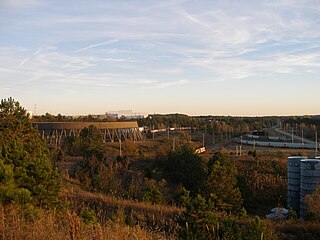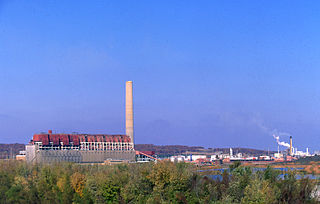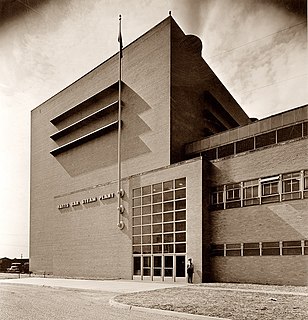
The Browns Ferry Nuclear Plant is located on the Tennessee River near Decatur and Athens, Alabama, on the north side of Wheeler Lake. The nuclear power plant is named after a ferry that operated at the site until the middle of the 20th century. The site has three General Electric boiling water reactor (BWR) nuclear generating units and is owned entirely by the Tennessee Valley Authority. Browns Ferry was TVA's first nuclear power plant; its approval occurred on June 17, 1966 and construction began in September 1966. In 1974, the time of its initial operation, it was the largest nuclear plant in the world. It was the first nuclear plant in the world to generate more than 1 gigawatt of power.

Turkey Point Nuclear Generating Station is a twin reactor nuclear power station located on a 3,300-acre (1,300 ha) site two miles east of Homestead, Florida, United States, next to Biscayne National Park located about 25 miles (40 km) south of Miami, Florida near the southernmost edge of Miami-Dade County. The facility is owned by Florida Power & Light.

The Sequoyah Nuclear Plant is a nuclear power plant located on 525 acres (212 ha) located 7 miles (11 km) east of Soddy-Daisy, Tennessee, and 20 miles (32 km) north of Chattanooga, abutting Chickamauga Lake, on the Tennessee River. The facility is owned and operated by the Tennessee Valley Authority (TVA).

The Watts Bar Nuclear Plant is a Tennessee Valley Authority (TVA) nuclear reactor pair used for electric power generation. It is located on a 1,770-acre (7.2 km²) site in Rhea County, Tennessee, near Spring City, between the cities of Chattanooga and Knoxville. Watts Bar supplies enough electricity for about 1,200,000 households in the Tennessee Valley.

The Alvin W. Vogtle Electric Generating Plant, also known as Plant Vogtle, is a 2 unit nuclear power plant located in Burke County, near Waynesboro, Georgia, in the southeastern United States. It is named after a former Alabama Power and Southern Company board chairman, Alvin Vogtle.

The Joseph M. Farley Nuclear Generating Plant is located near Dothan, Alabama in the southern United States. The twin-unit nuclear power station sits on a largely wooded and agricultural 1,850-acre (750 ha) site along the Chattahoochee River, approximately 5 miles (8.0 km) south of Columbia, Alabama in Houston County.

The South Texas Project Electric Generating Station, is a nuclear power station southwest of Bay City, Texas, United States. STP occupies a 12,200-acre (4,900 ha) site west of the Colorado River about 90 miles (140 km) southwest of Houston. It consists of two Westinghouse Pressurized Water Reactors and is cooled by a 7,000-acre (2,800 ha) reservoir, which eliminates the need for cooling towers. Only recently did the capacity of Palo Verde Nuclear Generating Station Unit 2 surpass either of these Texas units.

Quad Cities Generating Station is a two-unit nuclear power plant located near Cordova, Illinois, USA on the Mississippi River. The two General Electric boiling water reactors give the plant a total gross electric capacity of approximately 1,880 MW. It was named for the nearby cities of Moline, Illinois, Rock Island, Illinois, Davenport, Iowa, East Moline, Illinois, and Bettendorf, Iowa — known as the Quad Cities.
The "Nuclear Power 2010 Program" was launched in 2002 by President George W. Bush in order to restart orders for nuclear power reactors in the U.S. by providing subsidies for a handful of Generation III+ demonstration plants. The expectation was that these plants would come online by 2010, but it was not met.

The AP1000 is a nuclear power plant designed and sold by Westinghouse Electric Company. The plant is a pressurized water reactor with improved use of passive nuclear safety. The first AP1000 began operations in China at Sanmen Nuclear Power Station, where Unit 1 became the first AP1000 to achieve criticality in June 2018.

Nuclear power in the United States is provided by 99 commercial reactors with a net capacity of 100,350 megawatts (MW), 65 pressurized water reactors and 34 boiling water reactors. In 2016 they produced a total of 805.3 terawatt-hours of electricity, which accounted for 19.7% of the nation's total electric energy generation. In 2016, nuclear energy comprised nearly 60 percent of U.S. emission-free generation.

Widows Creek Fossil Plant was a 1.6-gigawatt coal power plant, 4.8 miles (7.7 km) east of Stevenson, Alabama, USA. The plant, operated by the Tennessee Valley Authority, generated about nine billion kilowatt-hours of electricity a year. It has one of the tallest chimneys in the world at 305 metres (1,001 ft), which was built in 1977.

Bull Run Fossil Plant, commonly known as Bull Run Steam Plant, is a 889 megawatt (MW), coal-fired electric generating station owned and operated by the Tennessee Valley Authority (TVA). The plant is the only coal fired power plant ever constructed by TVA with one unit, and is expected to close in 2023.
The William States Lee III Nuclear Station was a planned two-unit nuclear power plant in Cherokee County, South Carolina. Duke Energy filed the Combined Construction and Operating License (COL) application for the plant on December 13, 2007 to the NRC. On December 19, 2016, the NRC issued two Combined Licenses authorizing Duke to build and operate two AP1000 reactors at the site.

Between 2007 and 2009, 13 companies applied to the Nuclear Regulatory Commission for construction and operating licenses to build 31 new nuclear power reactors in the United States. However, the case for widespread nuclear plant construction has been hampered due to inexpensive natural gas, slow electricity demand growth in a weak US economy, lack of financing, and safety concerns following the Fukushima nuclear disaster.

The Yellow Creek Nuclear Plant is a canceled nuclear power plant project near Iuka, Mississippi. It was originally planned to have two 1,350-MW (output) reactors operated by the Tennessee Valley Authority (TVA). The steam turbine-generator sets were provided by General Electric.

The Johnsonville Fossil Plant is a 1.5-gigawatt, coal power plant located in New Johnsonville, Tennessee in Humphreys County, Tennessee. The plant generated electricity from 1951 to 2017. It was operated by the Tennessee Valley Authority (TVA).

Watts Bar Steam Plant was a 267-megawatt (MW), coal power plant operated by the Tennessee Valley Authority (TVA) located in Rhea County, Tennessee near the present site of Watts Bar Nuclear Plant and Watts Bar Dam. The plant was the first coal fired power plant constructed by TVA.




























